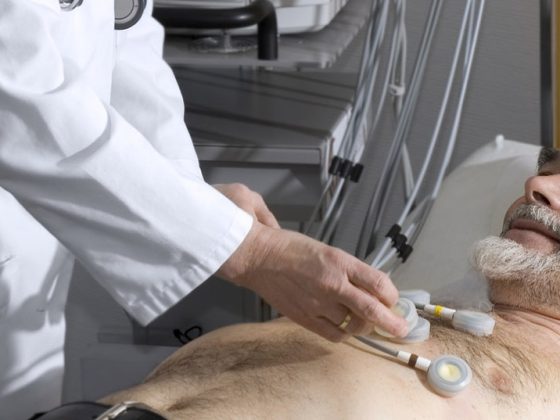Migraine can be highly restrictive and distressing for affected patients, and until recently there was no truly sustainable convincing therapeutic concept for effective and tolerable prophylaxis in sight. This has changed with the approval of antibodies for the prophylaxis of episodic and chronic migraine: With the introduction of CGRP antibodies, migraine prophylaxis with medication, which is intended to prevent the occurrence of migraine attacks, takes on a whole new significance in migraine therapy.
Migraine is a neurological disorder that only affects sufferers on “headache days” or “migraine days” – but then the disease sometimes severely restricts their daily and professional lives. A distinction is made between episodic and chronic migraine [1]: Chronic migraine is considered to be 15 or more headache days with at least eight migraine days per month for a duration of more than three months. If the sufferer suffers from up to 14 migraine days per month, it is an episodic migraine.[25]. Patients with chronic migraine primarily presented with episodic migraine that progressively worsened over years [2]. However, it is not only possible for migraine to become chronic – it is also possible to reverse this trend [3]. Important factors that may contribute to chronicity include acute medications, especially when medication overuse occurs. “The aim of treatment is firstly to prevent progression, i.e. chronification, and secondly to improve the quality of life of migraine patients, who should be able to live with as few migraines as possible or even migraine-free,” emphasizes PD Christoph J. Schankin, MD.
How the headache develops
Migraine has a complex underlying pathophysiology that is distinct from other forms of pain [4–6]. The main anatomical correlate of migraine pathophysiology is the trigeminovascular system, consisting of the trigeminal afferents and the cerebral vessels innervated by them. Both peripheral and central sensitization processes are involved in the development and propagation of migraine pain [7,8]. Thus, migraine is no longer considered a purely vascular disease, but rather a neuronal disease. But these findings are still quite new. “For decades, it was merely assumed that migraine came from the meningeal vessels and must be transmitted via a special nerve supplying the meninges… Then in the 1980s, it was noticed that when the meninges were touched, the blood vessels dilated and the patient felt pain. The molecule that was suspected even then of mediating this vasodilation, i.e. the transmission from the meninges to the brain, is the molecule CGRP, which is localized in the blood vessels around the meninges,” explains Andreas Gantenbein, MD. Today, it is believed that there are defined regions in the brainstem, the connection between the spinal cord and the cerebrum, that are activated by neurotransmitters [9] and that there is inflammation in the blood vessel wall of the meninges and expansion, resulting in the headache typical of migraine [10,11]. There may be a genetic predisposition in which certain triggers, such as stress or overwork, lead to attacks [12].
Therapy options
“Actually, all migraine therapies in recent decades have been discovered by accident,” Dr. Schankin said. “As part of the long-term therapies available to date, which attempt to reduce the number of migraine attacks, the patient must take daily medication that, although not specifically developed against migraine, nevertheless also work here, such as beta blockers, antiepileptic drugs and calcium antagonists. “Not least because of their relatively large number of side effects – such as fatigue, weight gain, concentration problems or mood deterioration – medications specifically developed against migraine are important,” he says. Drug treatment is divided into acute therapy to reduce symptoms of the current attack and stop the attack, and prophylactic therapy to prevent attacks and reduce their frequency, severity, and duration. For migraine attacks of low intensity and without daily restrictions, the Swiss Headache Society recommends peripherally acting analgesics and non-steroidal anti-inflammatory drugs in its therapy recommendations [13] for therapy in the acute phase. If the efficacy of these agents is not sufficient, or in the case of migraine attacks of moderate or high pain intensity and impairment in everyday life, triptans are advised. Prophylactic therapy is recommended for patients who suffer from at least three attacks and migraine headaches on more than 5 days per month, whose attacks are very severe or result in persistent neurologic deficits. In addition, prophylaxis is advised in cases of intolerance to acute therapeutic agents, medication overuse headache, marked limitation of quality of life, or patient preference. Migraine prophylaxis can be non-drug and drug. Drug prophylaxis is indicated for both episodic and chronic migraine [14]. The measure of effectiveness of preventive therapy is the reduction of migraine days by at least half. For this purpose, the patient must keep a migraine diary for a period of at least three months. The beta-blockers propranolol and metoprorol, the calcium antagonist flunarizine, and the anticonvulsants topiramate and valproic acid* as well as the tricyclic antidepressant amitriptyline are recommended in preventive therapy by the guidelines. For long-term prophylaxis, psychological pain therapy methods should also be used in addition. The drugs currently used in prophylaxis do not achieve the desired reduction in migraine days in many patients. In addition, they must be taken daily, which reduces adherence: only a quarter of all patients with chronic migraine correctly complete six months of treatment [30]. None of the active ingredients was developed specifically for migraine prophylaxis, and serious side effects occur in some cases.
* not approved in Switzerland for migraine prophylaxis

A new approach in migraine prophylaxis is CGRP antibodies [15–17]. “A few years ago, people had known about CGRP but didn’t know what to do with it,” notes Dr. Gantenbein. “In addition to very good efficacy, they are characterized by a very low side effect spectrum. In the studies, the discontinuation rate was very low, so it is hoped that these new therapeutic options will reduce the disease burden of patients in the long term. “Binding the CGRP antibody to the neurotransmitter CGRP can lead to a reduction in migraine attacks, since CGRP cannot bind to its receptor. A precise mechanism and site of action of CGRP inhibition have not been fully elucidated. The beneficial effect is thought to be due to reduced CGRP receptor activation in the trigeminal system. This mechanism of binding to the CGRP antibody is exhibited by three agents: Fremanezumab, Galcanezumab and Eptinezumab**. Another compound, erenumab, binds to the CGRP receptor, blocking the receptors and preventing the neurotransmitter from docking. These active ingredients in this substance class were developed specifically for migraine prophylaxis. Long half-lives make it possible to administer CGRP antibodies only once a month [18]. With the antibody fremanezumab, quarterly administration with a higher dosage is also possible in addition to the monthly injection. Significant efficacy in the prophylactic treatment of chronic and episodic migraine has been demonstrated for both dosages. Fremanezumab (AJOVY®) is approved in Switzerland [19] and is reimbursed by the health insurance companies after a cost assessment [20].
** not approved in Switzerland
The Phase III trials of the HALO study program evaluated the efficacy, safety, and tolerability of fremanezumab as a subcutaneous injection in the prophylactic treatment of adults with episodic and chronic migraine. In the studies, the antibody met all primary and secondary endpoints with both monthly and quarterly injections [21,22]. Treatment with fremanezumab significantly reduced the number of monthly migraine and headache days compared with placebo. In the studies, fremanezumab also impressed with its good tolerability and safety profile [21–23].
In the 12-week, placebo-controlled, randomized phase III HALO CM study, a total of 1130 patients with chronic migraine were enrolled and divided into three groups: Group 1 (n=376) received fremnezumab quarterly (675 mg); Group 2 (n=379) received fremanezumab monthly (675 mg / 225 mg /225 mg); and Group 3 (n=375) received placebo. As a result, quarterly administration of fremanezumab reduced the number of monthly headache days by 4.3 days compared with baseline, and the reduction for monthly administration was 4.6 days [22]. Significant treatment effects were observed under both dosing regimens as early as 1 week after the first dose.[19] The number of migraine days was also significantly reduced. For example, monthly dosing halved the number of headache days in 41% of patients (38% with quarterly dosing). Fremanezumab also significantly reduced the number of days patients required acute headache medication.
In the 12-week, placebo-controlled, randomized Phase III study. HALO EM [21] a total of 875 Patients with episodic migraine were included who had previously experienced at least six headache days per month, of which at least 4 were migraine days according to ICHD-3 classification [25]. Group 1 (n=291) received 675 mg fremanezumab once at baseline (quarterly dosing), Group 2 (n=290) received 225 mg fremanezumab for once-monthly dosing over three months, and Group 3 (n=294) received placebo only. As a result, the number of monthly migraine days (versus baseline) was significantly reduced in the two verum groups compared with placebo. Migraine days decreased by 3.7 (monthly dose), and 3.4 days (quarterly dose) compared with baseline [21]. Significant differences in efficacy compared to placebo were observed after only one week [19]. The proportion of patients with at least a 50 percent reduction in the average monthly number of migraine days during the first 12 weeks of treatment was significantly higher with fremanezumab than with placebo. At the monthly dose, 47.7% showed at least 50% improvement, compared with 44.4% at the quarterly dose. The number of days requiring acute medication was also significantly reduced in both fremanezumab arms [21].

Fig. 2: Response rates in EM patients

Fig. 3: Migraine freedom under fremanezumab in EM patients.
In a long-term study [23] following the HALO EM and CM, in which patients were further treated with the two dosing regimens monthly and quarterly – also blinded – according to the HALO studies, efficacy was maintained for up to 12 additional months. Efficacy did not decrease during treatment, but rather continued to increase during the treatment period (Fig. 1). Approximately 10% of CM patients and 20% of EM patients (Fig. 2) were completely pain-free [23]. Long-term treatment showed an acceptable safety profile and fremanezumab was well tolerated for up to 15 consecutive months. No safety signals were detected [24].
The FOKUS study [26] included patients with difficult-to-treat migraine who had already failed to respond adequately to 2-4 prophylactic prior therapies of different drug classes over the past 10 years. The primary endpoint was the change from baseline in mean monthly migraine days compared with placebo. Monthly migraine days were significantly reduced by 4.1 days (monthly dose) and 3.7 days (quarterly dose) compared with placebo (placebo 0.6). No safety signals were identified in this study either [26]. The results of the studies also speak for themselves in everyday practice: “Chronic migraine patients with 15 or more migraine days out of their everyday lives, including their professional lives, have now regained a 40-50 percent reduction in their migraine attacks and thus a high degree of improvement in quality of life,” Dr. Gantenbein and Dr. Schankin were convinced.
|
|
Literature:
-
Cho SJ, Chu MK: Risk Factors of Chronic Daily Headache or Chronic Migraine. Curr Pain Headache Rep 2015; 19: 465.
-
Lipton RB, Bigal ME: Migraine: Epidemiology, Impact, and Risk Factors for Progression. Headache 2005; 45 (Suppl 1): S3-S13.
-
Manack A, et al: Rates, predictors, and consequences of remission from chronic migraine to episodic migraine. Neurology 2011; 76:711-718.
-
World Health Organization. Headache disorders Fact sheet/Updated April 2016. Published online at: www.who.int/medi tre/factsheets/ fs277len (last accessed February 15, 2020).
-
German Migraine and Headache Society. Therapy of migraine attack and prophylaxis of migraine. Published online at: www. dgn.org/guidelines/3583-II-030-057-2018-therapy-of-migraeneattack-and-prophylaxis-of-migraene# introduction (last accessed February 15, 2020).
-
German Pain Society e. V. Section of the International Association for the Study of Pain (IASP). Headache. Published online at: www.schmerzgesellschaft.de/topnavi/patienten information/pain-diseases/headaches (last accessed February 15, 2020).
-
Meßlinger K, Dux M: New therapeutic options for migraine. Neurology 2016; 7/8: 492-500.
-
Burstein R, et al: Migraine: Multiple Processes, Complex Pathophysiology. The Journal of Neuroscience 2015; 35(17): 6619-6629.
-
Cady RK, et al: Elevated Saliva Calcitonin Gene-Related Peptide Levels During Acute Migraine Predict Therapeutic Response to Rizatriptan. Headache 2009; GRP49: 1258-1266.
-
Lassen LH, et al: CGRP may play a causative role in migraine.Cephalalgia 2002; 22: 54-61.
-
Cernuda-Morollon Et, et al: Interictal increase of CGRP levels in peripheral blood as a biomarker for chronic migraine. Neurology 2013; 81: 1191-1196.
-
Charles AC, et al: The pathophysiology of migraine: implications for clinical management. Lancet Neurol 2018; 17: 174-182
-
Treatment recommendations for primary headache. Swiss Headache Society; 10th, fully revised edition, 2019; www.headache.ch/download/Content_ attachments/FileBaseDoc/SKG_Therapy_Recommendations 2018_EN 15 _WEB.pdf (last accessed February 15, 2020).
-
Neeb L, Reuter R, Israel H: CGRP as a therapeutic target in the treatment of primary headache. Neurology 2017; 5: 334-343.
-
Stauffer VL, et al: Evaluation of Galcanezumab for the Prevention of episodic Migraine: The EVOLVE-1 Randomized Clinical Trial. JAMA Neurol. 2018 Sep 1; 75(9): 1080-1088.
-
Dodick DW, et al: ARISE: A phase 3 randomized trial of erenumab for episodic migraine. Cephalalgia. 2018; May; 38(6): 1026-1037.
-
Silberstein SD, et al: Fremanezumab for the Preventive Treatment of Chronic Migraine. N Engl J Med 2017; 377: 2113-2122.
-
Rujan RM, et al: Caleitonin Gene-Related Peptide Antagonists and Therapeutic Antibodies. Handb Exp Pharmacol. Springer Verlag 2019; 255:169- 192.
-
AJOVY® Technical Information; www.swissmedicinfo.ch
-
Limitatio AJOVY®; www.spezialitätenliste.ch/ ShowPreparations.aspx (last accessed on 01.03.2020)
-
Dodick DW, et al: Effect of Fremanezumab Compared With Placebo for Prevention of Episodic Migraine. A Randomized Clinical Trial. JAMA 2018; 319: 1999-2008.
-
Silberstein SD, et al: Fremanezumab for the Preventive Treatment of Chronic Migraine. N Engl J Med 2017; 377: 2113-2122.
-
Goadsby PJ, et al: Long-Term Efficacy and Safety of Fremanezumab in Migraine: Results of a 1-Year Study. E-Poster 015; Presented at EHF Congress 2019; Athens, Greece, May 30-June 1.
-
Ning X, et al: Long-Term Safety of Fremanezumab: Results of a 1-Year Study. Poster 1.015; Presented at AAN Congress 2019; Philadelphia, Pennsylvania, USA, May 4-10.
-
Headache Classification Committee of the International Headache Society (IHS). The International Classification of Headache Disorders, 3rd edition. Published online at: www.ihs-headache.org/binary_data/3245_ichd- 3-cephalalgia-2018-issue-1.pdf (last accessed February 15, 2020).
-
Ferrari MD, et al: Fremanezumab vesus placebo for migraine prevention in patients with documented failure to up to four migraine preventive medication classes (FOCUS): a randomized, double-blind, placebo-controlled, phase 3b trial. Lancet 2019; 394: 1030-1040.
-
Raddant AC, et al: Calcitonin gene-related peptide in migraine: intersection of peripheral inflammation and central modulation. Expert Rev Mol Med 2012; 13; e36. doi:10.1017/ S1462399411002067.
-
Walter S, et al: TEV-48125: a Review of a Monoclonal CGRP Antibody in Development for the Preventive Treatment of Migraine. Curr Pain Headache Rep 2015; 19(3): 6.
-
Newman LC, et al: Long-Term Impact of Fremanezumab on Response Rates: Results of a 1-year Study. E-Poster 010; Presented at RHF Congress 2019; Athens, Greece, May 30-June 1.
- Hepp Z, et al: Persistance and switching patterns of oral migraine prophylactic medications among patients with chronic migraine: A retroperspective claims analysis. Cephalalgia 2017; 37(5): 470-485.


 PD Andreas Gantenbein, MD
PD Andreas Gantenbein, MD PD Christoph J. Schankin, MD
PD Christoph J. Schankin, MD









